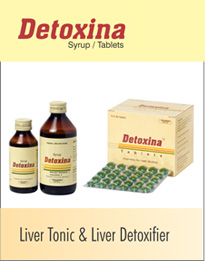Products

Detoxina - Syrup/Tablets
Therapeutic Category : Hepato-protective & Appetite Stimulant
Therapeutic Category : Hepato-protective & Appetite Stimulant
Actions
Individual botanicals in Detoxina tablets & syrup have multiple hepato-tropic actions which help in :
- Maintaining structural and functional integrity of the liver,
- Protecting hepatic metabolizing enzymes,
- Overcoming hepatic inflammation & oedema,
- Normalising impaired hepatic function and abnormal liver function tests,
- Stimulating active liver cell proliferation and liver cell regeneration,
- Correcting impaired hepato-cellular bile production and promotes bile flow,
- Increasing hepato-cellular antioxidant capacity & hepatic detoxification capacity
- Improving appetite, digestion and growth.
Botanicals in Detoxina also exhibit specific HBV antiviral activity to :
- Inactivate HBV viral surface antigen
- Inhibit HBV replication by inhibiting the viral DNA polymerase
Indications
In cases of
- Anorexia (Kshudhamandya)
- Growth failure (Vruddhi viphalata)
- Chronic indigestion (Ajirna)
- Convalescence (Rogopasamana)
- Malnutrition (Kuposhana)
- Prophylatically with anti-TB drugs Adults : 1 tablet o.i.d. or 15 ml (tablespoonful) once a day
Children : 10 ml (2 teaspoonfuls) once a day
In cases of
- Mild to moderate liver dysfunction associated with alcohol consumption or associated with
hepatotoxic drugs
Adults : 1 tablet b.i.d. or 15 ml (tablespoonful) twice a day
Children : 10 ml (2 teaspoonfuls) twice a day
In cases of
- Jaundice(Kamala)
- Hepatitis B infection
- Liver cirrhosis(Halimaka) Adults : 1 tablet t.i.d or 15 ml (tablespoonful) thrice a day
Children : 10 ml (2 teaspoonfuls) thrice a day




